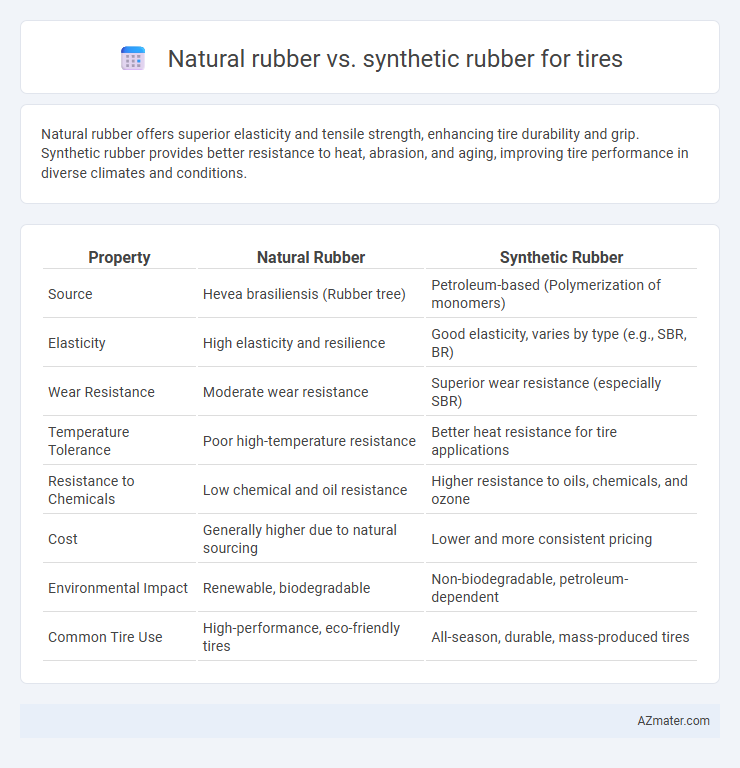Natural rubber offers superior elasticity and tensile strength, enhancing tire durability and grip. Synthetic rubber provides better resistance to heat, abrasion, and aging, improving tire performance in diverse climates and conditions.
Table of Comparison
| Property | Natural Rubber | Synthetic Rubber |
|---|---|---|
| Source | Hevea brasiliensis (Rubber tree) | Petroleum-based (Polymerization of monomers) |
| Elasticity | High elasticity and resilience | Good elasticity, varies by type (e.g., SBR, BR) |
| Wear Resistance | Moderate wear resistance | Superior wear resistance (especially SBR) |
| Temperature Tolerance | Poor high-temperature resistance | Better heat resistance for tire applications |
| Resistance to Chemicals | Low chemical and oil resistance | Higher resistance to oils, chemicals, and ozone |
| Cost | Generally higher due to natural sourcing | Lower and more consistent pricing |
| Environmental Impact | Renewable, biodegradable | Non-biodegradable, petroleum-dependent |
| Common Tire Use | High-performance, eco-friendly tires | All-season, durable, mass-produced tires |
Introduction to Rubber Types in Tire Manufacturing
Natural rubber, derived from the latex sap of Hevea brasiliensis trees, offers exceptional elasticity, resilience, and tear resistance essential for tire performance. Synthetic rubber, produced from petrochemical polymers like styrene-butadiene rubber (SBR) and polybutadiene, provides enhanced abrasion resistance and heat stability, optimizing tire durability under various driving conditions. Tire manufacturing blends natural and synthetic rubbers to balance traction, wear resistance, and cost efficiency for diverse vehicle applications.
Overview of Natural Rubber: Sources and Properties
Natural rubber, primarily harvested from the Hevea brasiliensis tree, is prized for its exceptional elasticity, resilience, and tensile strength, making it ideal for tire manufacturing. Its molecular structure consists of cis-1,4-polyisoprene, which provides superior abrasion resistance and high dynamic performance, crucial for road grip and durability. Sourced mainly from Southeast Asia, natural rubber's biodegradability and eco-friendly characteristics contrast sharply with synthetic rubber derived from petrochemicals.
Synthetic Rubber: Types and Key Characteristics
Synthetic rubber used in tire manufacturing primarily includes styrene-butadiene rubber (SBR), butadiene rubber (BR), and nitrile rubber (NBR), each offering unique performance benefits. SBR provides excellent abrasion resistance and aging stability, BR contributes superior wear resistance and low rolling resistance, while NBR offers enhanced oil and heat resistance. These types enable synthetic rubber tires to deliver improved durability, fuel efficiency, and adaptability across various driving conditions compared to natural rubber.
Historical Development of Rubber in Tires
Natural rubber, harvested primarily from Hevea brasiliensis trees, was the foundational material for tire manufacturing in the late 19th and early 20th centuries, valued for its elasticity and resilience. During World War II, synthetic rubber, derived from petroleum-based polymers like styrene-butadiene, gained prominence due to natural rubber shortages, leading to its widespread industrial adoption. The historical shift reflects advancements in polymer chemistry and global resource availability, shaping modern tire performance and production efficiency.
Performance Comparison: Grip, Durability, and Safety
Natural rubber offers superior grip due to its excellent elasticity and resistance to wear, enhancing tire traction in wet and dry conditions. Synthetic rubber provides better durability and heat resistance, making tires more resilient under high-speed and heavy-load scenarios. Safety is optimized by combining both rubbers in tire formulations to balance grip and longevity, ensuring reliable performance across diverse driving environments.
Environmental Impact: Sustainability and Carbon Footprint
Natural rubber, derived from rubber tree latex, offers a renewable and biodegradable option with a lower carbon footprint compared to synthetic rubber, which is produced from petrochemicals and contributes significantly to greenhouse gas emissions. The cultivation of natural rubber supports carbon sequestration and biodiversity but demands careful land management to prevent deforestation and habitat loss. Synthetic rubber production relies heavily on fossil fuels, leading to higher energy consumption and environmental pollution, making it less sustainable in terms of long-term ecological impact.
Cost Analysis: Production and Market Pricing
Natural rubber typically incurs higher production costs due to its reliance on agricultural factors such as climate and harvest cycles, impacting supply stability and price volatility. Synthetic rubber, derived from petroleum-based feedstocks, offers more consistent production costs and market pricing but is subject to fluctuations in crude oil prices and refining expenses. Market pricing for tires reflects these differences, with synthetic rubber tires generally priced more competitively, while natural rubber tires may command premiums during periods of high demand or supply constraints.
Application Suitability: Passenger Cars vs Heavy-Duty Vehicles
Natural rubber offers superior elasticity and abrasion resistance, making it ideal for passenger car tires that require flexibility and comfort for everyday driving. Synthetic rubber, such as styrene-butadiene rubber (SBR), provides enhanced heat resistance and durability, which suits heavy-duty vehicle tires subjected to higher loads and harsh operating conditions. Combining both rubbers in tire compounds allows optimization for specific applications, balancing ride quality in passenger cars with performance and wear resistance in heavy-duty vehicles.
Innovations and Future Trends in Tire Rubber Materials
Advancements in tire rubber materials emphasize innovative blends of natural rubber and synthetic rubber to enhance durability, performance, and environmental sustainability. Emerging research explores bio-based synthetic polymers and reinforced natural rubber composites that improve wear resistance and fuel efficiency in tires. Future trends indicate a shift towards eco-friendly, high-performance compounds leveraging nanotechnology and green chemistry to reduce carbon footprint while maintaining superior traction and longevity.
Conclusion: Choosing the Right Rubber for Tires
Natural rubber offers superior elasticity, resilience, and wear resistance, making it ideal for high-performance tires in demanding conditions. Synthetic rubber provides enhanced durability, better heat resistance, and cost-effectiveness, suited for mass production and varied climates. Selecting the right rubber depends on balancing performance requirements, environmental factors, and budget constraints to optimize tire safety and longevity.

Infographic: Natural rubber vs Synthetic rubber for Tire
 azmater.com
azmater.com